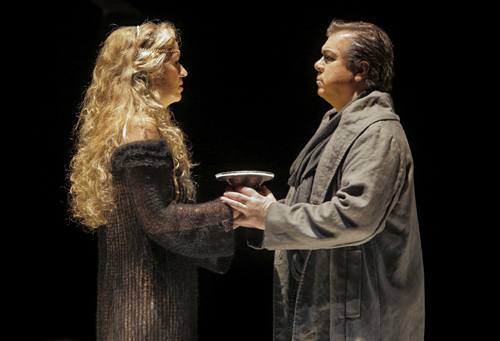 Finland Wagner Tristan und Isolde: Soloists, Chorus and Orchestra of the Finnish National Opera, Helsinki, Pinchas Steinberg (conductor). Finnish National Opera 17.5.2013 (Premiere) (GF)
Finland Wagner Tristan und Isolde: Soloists, Chorus and Orchestra of the Finnish National Opera, Helsinki, Pinchas Steinberg (conductor). Finnish National Opera 17.5.2013 (Premiere) (GF)
Cast:
Tristan: Robert Dean Smith
Isolde: Marion Ammann
Brangäne: Lilli Paasikivi
Kurwenal: Tommi Hakala
Marke: Matti Salminen
Melot: Waltteri Torikka
Shepherd: Oiva Lehtonen, Kai Pitkänen (singer)
Steersman: Arto Hosio
A young sailor: Tuomas Katajala
Direction: Elisabeth Linton
Sets: Steffen Aarfing
Costumes: Marie í Dali
Lighting design: Jesper Kongshaug

Tristan and Isolde have been rare guests in Helsinki. The first time was 1921, then in 1946 and the last premiere until now was in 1965. Totally the opera has been seen only 30 times. Expectations have been high and there is no doubt that the new production was worth waiting for.
Costumes are roughly modern, sets are simple but efficient: act I on board a big ship, act II some tree-trunks in the dark night with a large moon hanging above, act III a heap of planks in a big empty room – Kareol is in disrepair. If all this sounds prosaic it is in fact the other way round. The production team have urged and inspired the singers to dig deep into their characters and the second act is so emotionally charged that one regrets the appearance of Marke and his men, breaking the magic spell that made time stand still. Tristan und Isolde is musically probably the most beautiful creation of Wagner but in a workaday production it can seem overlong even so. Not so in Helsinki. The visuals, the action and the music merged into a totality that became totally overwhelming.
Overwhelming, that is, not in the shape of leather-lunged histrionics and spectacular orchestral fireworks. Pinchas Steinberg took as his starting-point the fact that Tristan und Isolde to a great extent is chamber music, with transparent textures and often highlighting individual instruments. I have praised the FNO orchestra on many occasions and the ovations they were met with after the performance were certainly well deserved. And this chamber sized reading was a perfect match to the two leading singers. I heard Robert Dean Smith as a marvellous Tristan at Bayreuth five years ago. He is no Melchior but he has possibly the most beautiful tenor voice among today’s Tristans. And in this production, and admittedly in a smaller house than the Festspielhaus on the Green Hill he could scale down to a more intimate format. The opening phrases of O sink hernieder, Nacht der Liebe, sung pianissimo, were truly ravishing. And time and again he demonstrated that less is often more when it comes to conveying inner feelings. But he has heft too, and when he let loose at full throttle one felt that here is a mastersinger. The most impressive was no doubt his long and enormously strenuous solo in the last act. From when he wakes up, to the joy of Kurwenal, and almost inaudibly asks ‘Where am I?’ and then gradually rises and delivers his long soliloquy where he curses his fate: to die of longing. I have heard tenors half whispering the last lines, exhausted to the extreme limit of their powers. Robert Dean Smith sounded just as fresh as he did when he sang his first phrases almost five hours earlier.
His Isolde, the Swiss soprano Marion Ammann was a new acquaintance to me. I had read a review of her Isolde some years ago and I can’t resist quoting a couple of lines: ‘But be warned–especially those awaiting the Second Coming of St. Birgit: Ammann is different and quite possibly a throwback to an earlier epoch. How such a solid but beautiful sound can emanate from such a slender, willowy torso is truly a wonder.’ (Operablog). She was quite sensational. With a lyrical voice of great beauty, an ideal voice for the Figaro Countess, she impersonated a young infatuated woman who enthralled me – and, quite likely, the rest of the audience – from beginning to end. Instead of the brazen trombone of Flagstad or the silver trumpet of Nilsson hers was the sweetest violin imaginable. By some lucky coincidence the two voices blended marvellously well in the love duet and her Liebestod was so lovely sung that only Margaret Price on Carlos Kleiber’s recording was anywhere close in approach and beauty.
But the rest of the cast were not just a group of nobodies either. Lilli Paasikivi, who will be the new Artistic Director at the FNO from August 2013, was a Brangäne of distinction and she sang Einsam wachend in der Nacht with lyrical warmth. Tommi Hakala was a strong Kurwenal and he acted convincingly. Matti Salminen has been singing all the big Wagnerian bass roles and at almost 68 he is still in tremendous shape. His is the blackest and most voluminous voice around and his Tatest du’s wirklich? was so deeply felt that it was the most touching and memorable moment of the whole performance. The minor roles were also well taken.
The new Tristan und Isolde in Helsinki should be seen – and heard – by every Wagnerian.
Göran Forsling